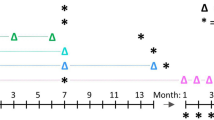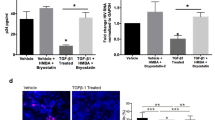Abstract
Traditional gene therapy vectors have demonstrated limited utility for treatment of chronic lung diseases such as cystic fibrosis (CF). Herein we describe a vector based on a Filovirus envelope protein-pseudotyped HIV vector, which we chose after systematically evaluating multiple strategies. The vector efficiently transduces intact airway epithelium from the apical surface, as demonstrated in both in vitro and in vivo model systems. This shows the potential of pseudotyping in expanding the utility of lentiviral vectors. Pseudotyped lentiviral vectors may hold promise for the treatment of CF.
This is a preview of subscription content, access via your institution
Access options
Subscribe to this journal
Receive 12 print issues and online access
$209.00 per year
only $17.42 per issue
Buy this article
- Purchase on Springer Link
- Instant access to full article PDF
Prices may be subject to local taxes which are calculated during checkout




Similar content being viewed by others
References
Davis, P.B., Drumm, M. & Konstan, M.W. Cystic fibrosis. Am. J. Respir. Crit. Care Med. 154, 1229–1256 (1996).
Buchschacher, G.L. Jr. & Wong-Staal, F. Development of lentiviral vectors for gene therapy for human diseases. Blood. 95, 2499–2504 (2000).
Peng, K.W. & Russell, S. J. Viral vector targeting. Curr. Opin. Biotechnol. 10, 454–457 (1999).
Schnierle, B.S. & Groner, B. Retroviral targeted delivery. Gene Ther. 3, 1069–1073 (1996).
Goldman, M.J., Lee, P.S., Yang, J.S. & Wilson, J.M. Lentiviral vectors for gene therapy of cystic fibrosis. Hum Gene Ther. 8, 2261–2268 (1997).
Wang, G. et al. Feline immunodeficiency virus vectors persistently transduce nondividing airway epithelia and correct the cystic fibrosis defect. J Clin. Invest. 104, R55–62 (1999).
Johnson, L.G., Olsen, J.C., Naldini, L. & Boucher, R.C. Pseudotyped human lentiviral vector-mediated gene transfer to airway epithelia in vivo. Gene Ther. 7, 568–574 (2000).
Kobinger, G.P. et al. Virion-targeted viral inactivation of human immunodeficiency virus type 1 by using Vpr fusion proteins. J. Virol. 72, 5441–5448 (1998).
Gelderblom H.R. Assembly and morphology of HIV: potential effect of structure on viral function. Aids. 5, 617–637 (1991).
Mochizuki, H., Schwartz, J.P., Tanaka, K., Brady, R.O. & Reiser, J. High-titer human immunodeficiency virus type 1-based vector systems for gene delivery into nondividing cells. J. Virol. 72, 8873–8883 (1998).
Dong, J., Roth, M.G. & Hunter, E. A chimeric avian retrovirus containing the influenza virus hemagglutinin gene has an expanded host range. J. Virol. 66, 7374–7382 (1992).
Battini, J.L., Heard, J.M. & Danos, O. Receptor choice determinants in the envelope glycoproteins of amphotropic, xenotropic, and polytropic murine leukemia viruses. J. Virol. 66, 1468–1475 (1992).
Holberg, C.J. et al. Risk factors for respiratory syncytial virus-associated lower respiratory illnesses in the first year of life. Am. J. Epidemiol. 133, 1135–1151 (1991).
Johnson, E., Jaax, N., White, J. & Jahrling, P. Lethal experimental infections of rhesus monkeys by aerosolized Ebola virus. Int. J. Exp. Pathol. 76, 227–236 (1995).
Snyder, E.Y. et al. Multipotent neural cell lines can engraft and participate in development of mouse cerebellum. Cell 68, 33–51 (1992).
Yang, Z. et al. Distinct cellular interactions of secreted and transmembrane Ebola virus glycoproteins. Science 279, 1034–1037 (1998).
Wool-Lewis, R.J. & Bates, P. Characterization of Ebola virus entry by using pseudotyped viruses: identification of receptor-deficient cell lines. J. Virol. 72, 3155–3160 (1998).
Chan, S., Speck, R., Ma, M. & Goldsmith, M. Distinct mechanisms of entry by envelope glycoproteins of Marburg and Ebola (Zaire) viruses. J. Virol. 74, 4933–4937 (2000).
Bals, R. et al. Transduction of well-differentiated airway epithelium by recombinant adeno-associated virus is limited by vector entry. J. Virol. 73, 6085–6088 (1999).
Engelhardt, J.F., Yankaskas, J.R. & Wilson, J.M. In vivo retroviral gene transfer into human bronchial epithelia of xenografts. J. Clin. Invest. 90, 2598–2607 (1992).
Olsen, J.C. et al. Correction of the apical membrane chloride permeability defect in polarized cystic fibrosis airway epithelia following retroviral-mediated gene transfer. Hum. Gene Ther. 3, 253–266 (1992).
Zabner, J. et al. Adeno-associated virus type 5 (AAV5) but not AAV2 binds to the apical surfaces of airway epithelia and facilitates gene transfer. J. Virol. 74, 3852–3858 (2000).
Yonemitsu, Y. et al. Efficient gene transfer to airway epithelium using recombinant Sendai virus. Nat. Biotechnol. 18, 970–973 (2000).
Lopez-Vidriero, M.T. & Reid, L. Chemical markers of mucous and serum glycoproteins and their relation to viscosity in mucoid and purulent sputum from various hypersecretory diseases. Am. Rev. Respir. Dis. 117, 465–477 (1978).
Crawford, I. et al. Immunocytochemical localization of the cystic fibrosis gene product CFTR. Proc. Natl. Acad. Sci. USA 88, 9262–9266 (1991).
Duan, D., Yue, Y., Yan, Z., Yang, J. & Engelhardt, J.F. Endosomal processing limits gene transfer to polarized airway epithelia by adeno-associated virus. J. Clin. Invest. 105, 1573–1587 (2000).
Wang, G. et al. Influence of cell polarity on retrovirus-mediated gene transfer to differentiated human airway epithelia. J. Virol. 72, 9818–9826 (1998).
Engelhardt, J.F. et al. Direct gene transfer of human CFTR into human bronchial epithelia of xenografts with E1-deleted adenoviruses. Nat. Genet. 4, 27–34 (1993).
Blomer, U. et al. Highly efficient and sustained gene transfer in adult neurons with a lentivirus vector. J. Virol. 71, 6641–6649 (1997).
Lodge, R., Subbramanian, R.A., Forget, J., Lemay, G. & Cohen, E.A. MuLV-based vectors pseudotyped with truncated HIV glycoproteins mediate specific gene transfer in CD4+ peripheral blood lymphocytes. Gene Ther. 5, 655–664 (1998).
Yao, X.J., Kobinger, G., Dandache, S., Rougeau, N. & Cohen, E. HIV-1 Vpr-chloramphenicol acetyltransferase fusion proteins: sequence requirement for virion incorporation and analysis of antiviral effect. Gene Ther. 6, 1590–1599 (1999).
Dull, T. et al. A third-generation lentivirus vector with a conditional packaging system. J. Virol. 72, 8463–8471 (1998).
Acknowledgements
The authors thank Dr. Inder Verma for providing pCMVΔR8.2, pHR′LacZ, and the VSV-G envelope expressor, Dr. Paul Bates for providing the EboZ and EboR envelope plasmids as well as antibodies against the Ebola envelope glycoprotein, Dr. Eric Hunter for providing the BH-RCANsHA envelope plasmid, Dr. Jacob Reizer for providing the Mokola envelope plasmid, Dr. Eric Cohen for providing the SVCMV in plasmid and the amphotropic MuLV envelope, Dr. Christian Moser for insightful discussion, and Dr. John Tazelaar for assistance with tissue processing and microscopy. G.P.K. is the recipient of a fellowship from the Medical Research Council of Canada. This work was funded by grants from the National Institutes of Health (DK47757-08), the CF Foundation, and Genovo, Inc., a biotechnology company Dr. Wilson founded and in which he has equity.
Author information
Authors and Affiliations
Corresponding author
Rights and permissions
About this article
Cite this article
Kobinger, G., Weiner, D., Yu, QC. et al. Filovirus-pseudotyped lentiviral vector can efficiently and stably transduce airway epithelia in vivo. Nat Biotechnol 19, 225–230 (2001). https://doi.org/10.1038/85664
Received:
Accepted:
Issue Date:
DOI: https://doi.org/10.1038/85664
This article is cited by
-
MICU1 protects against myocardial ischemia/reperfusion injury and its control by the importer receptor Tom70
Cell Death & Disease (2017)
-
The retroviral vector family: something for everyone
Virus Genes (2017)
-
Understanding lentiviral vector chromatin targeting: working to reduce insertional mutagenic potential for gene therapy
Gene Therapy (2013)
-
Airway gene transfer in a non-human primate: Lentiviral gene expression in marmoset lungs
Scientific Reports (2013)
-
Lentiviral Delivery of RNAi for In Vivo Lineage-Specific Modulation of Gene Expression in Mouse Lung Macrophages
Molecular Therapy (2013)



